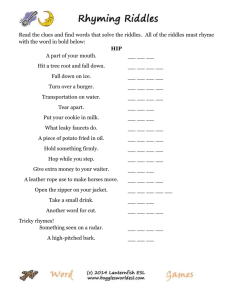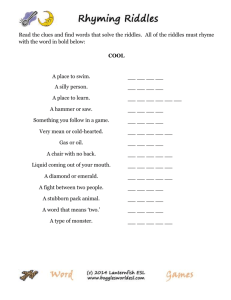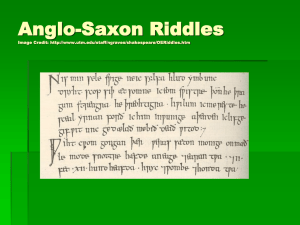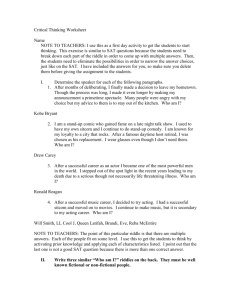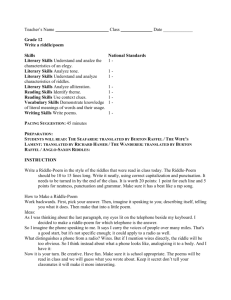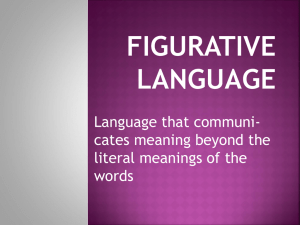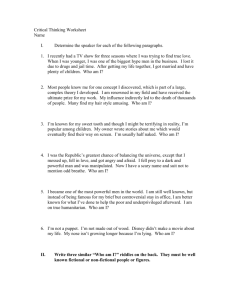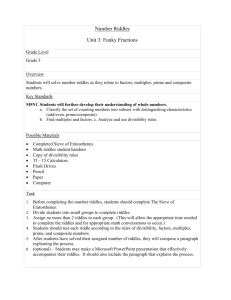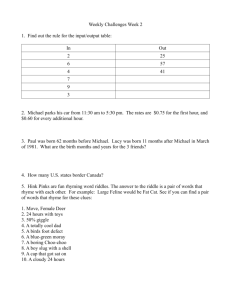Document 10464954
advertisement
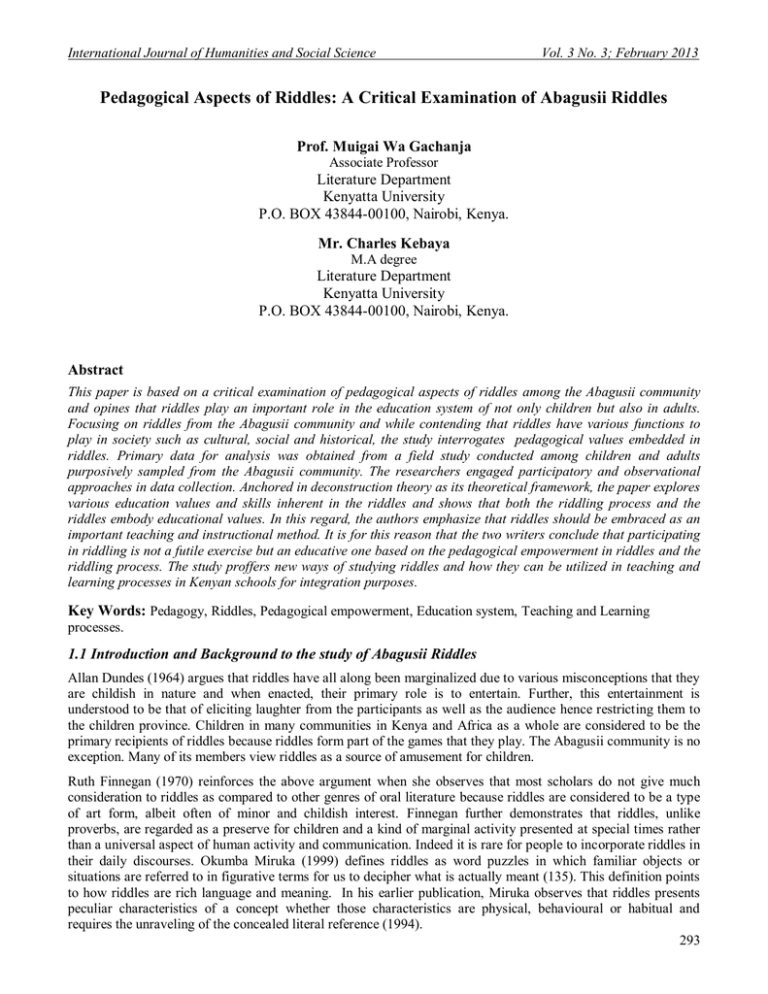
International Journal of Humanities and Social Science Vol. 3 No. 3; February 2013 Pedagogical Aspects of Riddles: A Critical Examination of Abagusii Riddles Prof. Muigai Wa Gachanja Associate Professor Literature Department Kenyatta University P.O. BOX 43844-00100, Nairobi, Kenya. Mr. Charles Kebaya M.A degree Literature Department Kenyatta University P.O. BOX 43844-00100, Nairobi, Kenya. Abstract This paper is based on a critical examination of pedagogical aspects of riddles among the Abagusii community and opines that riddles play an important role in the education system of not only children but also in adults. Focusing on riddles from the Abagusii community and while contending that riddles have various functions to play in society such as cultural, social and historical, the study interrogates pedagogical values embedded in riddles. Primary data for analysis was obtained from a field study conducted among children and adults purposively sampled from the Abagusii community. The researchers engaged participatory and observational approaches in data collection. Anchored in deconstruction theory as its theoretical framework, the paper explores various education values and skills inherent in the riddles and shows that both the riddling process and the riddles embody educational values. In this regard, the authors emphasize that riddles should be embraced as an important teaching and instructional method. It is for this reason that the two writers conclude that participating in riddling is not a futile exercise but an educative one based on the pedagogical empowerment in riddles and the riddling process. The study proffers new ways of studying riddles and how they can be utilized in teaching and learning processes in Kenyan schools for integration purposes. Key Words: Pedagogy, Riddles, Pedagogical empowerment, Education system, Teaching and Learning processes. 1.1 Introduction and Background to the study of Abagusii Riddles Allan Dundes (1964) argues that riddles have all along been marginalized due to various misconceptions that they are childish in nature and when enacted, their primary role is to entertain. Further, this entertainment is understood to be that of eliciting laughter from the participants as well as the audience hence restricting them to the children province. Children in many communities in Kenya and Africa as a whole are considered to be the primary recipients of riddles because riddles form part of the games that they play. The Abagusii community is no exception. Many of its members view riddles as a source of amusement for children. Ruth Finnegan (1970) reinforces the above argument when she observes that most scholars do not give much consideration to riddles as compared to other genres of oral literature because riddles are considered to be a type of art form, albeit often of minor and childish interest. Finnegan further demonstrates that riddles, unlike proverbs, are regarded as a preserve for children and a kind of marginal activity presented at special times rather than a universal aspect of human activity and communication. Indeed it is rare for people to incorporate riddles in their daily discourses. Okumba Miruka (1999) defines riddles as word puzzles in which familiar objects or situations are referred to in figurative terms for us to decipher what is actually meant (135). This definition points to how riddles are rich language and meaning. In his earlier publication, Miruka observes that riddles presents peculiar characteristics of a concept whether those characteristics are physical, behavioural or habitual and requires the unraveling of the concealed literal reference (1994). 293 © Centre for Promoting Ideas, USA www.ijhssnet.com This assertion further implies that riddles contain in them certain characteristics that ought to be studied in order to reveal their richness in terms of style, language and embedded knowledge. Therefore, the study of Abagusii riddles is a worthy course since it will add on the existing knowledge on riddles in oral literature and pedagogy. Peter Hunt (1994) argues that the best way for everybody to study riddles is to simply have a notion that He is because of what he acquired in childhood (45). He argues that it is probable that many people who could consider themselves extremely sophisticated and advanced are actually carrying through life an imaginary background, which they acquired in childhood. Childhood experiences play a pivotal role in shaping an individual‟s adult life. Some of these experiences include the riddling process, common among children in their early days of growing up. In this regard, riddles must be seen as a part and parcel of every person‟s life more so because they could have experienced them at some point in their life and might have acquired certain skills through riddling which they have inculcated in their daily life. In this regard, riddles should be seen as an integral part of everybody‟s life both the young and the old alike. In this paper, we endeavour to examine the pedagogical aspects of Abagusii riddles. The paper seeks to demystify the notion that riddles are childish and are a preserve for children by showing their richness not only in style and meaning but also in pedagogy, aspects which can be utilized in the teaching and learning processes in Kenyan schools. While engaging deconstruction theory in the interpretation of embedded meaning(s) in selected riddles for this study, we seek to establish pedagogical values that accrue from riddles and the riddling process in the society. Our preliminary research established that there is little critical attention on Abagusii riddles by scholars from the community and even from outside the community. So far, there only exists a collection of riddles from the community by Z. Abuga, S.A Kiyondi and H. Manani, who together with the National Centre for Early Childhood Education (NACECE) of KIE have documented Abagusii riddles in a book, Amatera N’Emegeno (Ekegusii). However, this study established that there is no interpretation of these riddles other than the documentation. The text remains mute for instance on the performance and social significance of riddles among the Abagusii. Aspects such as the use of language in riddles, the influence of the environment in the crafting of riddles among others are not examined either in this text. Further, our library and internet research revealed that there is no literary study of riddles among the Abagusii. This forms the thrust of this paper as we examine the pedagogical aspects of riddles among the Abagusii of western Kenya. This paper further underscores the need for both the young and adults to get involved in riddling since it is not only a skilful endeavour but will also improve one‟s language power, knowledge and grasp of the immediate environment and social and pedagogical values entrenched in them. 1.2 Scope, Materials and Methods 1.2.1 Scope and Delimitation Riddles collected from the Abagusii community of western Kenya constituted the primary source of data for this study. In our analysis, we focused on pedagogical aspects embedded in the riddles that would be of benefit to both children and adults alike. Features of style evident in the riddles were analysed insofar as they informed and/or influenced the pedagogical aspects that formed the subject of this study. 1.2.2 Materials and Method The study was anchored in descriptive survey as its research design. The major purpose of this research design is the description of the state of affairs as they are and involves the analysis and interpretation of data. The researchers adopted a self-observation approach during the collection of data for analysis. The researchers closely participated and observed the riddling process among children. At the end of each riddling session, the researchers asked the children about what they have learnt from the riddle. The riddles were recorded as performed by children and later, a direct translation from vernacular to English was done. Both the performed and translated texts were analysed in terms of their pedagogical values. The study utilized systematic content analysis in examining pedagogical aspects of riddles. 1.3 Theorizing the interpretation of Riddles We anchor our interpretation of riddles among the Abagusii community within deconstruction as a theoretical framework that will primarily enable us conduct a thorough analysis of pedagogical aspects in the riddles, appreciate the fluidity of language and depict the diversity in meaning of the riddles. 294 International Journal of Humanities and Social Science Vol. 3 No. 3; February 2013 Jacques Derrida argues that deconstruction involves a careful teasing of warring forces of signification within the text, in this case, a riddle. These forces of signification are embedded in the language of the text. Indeed, deconstruction theory holds that language in any work of art is elusive and therefore keeps on attracting different interpretations. Further, Derrida observes that there exists on universal truth or single interpretation to a work of art since the same work may be interpreted differently by different scholars. In our interpretation, we espoused the postulations of Deconstruction as advanced by Derrida since it is admissible to a multiplicity of meanings that come about due to different interpretations of the same text. It as well allows us to explore the various possibilities in the interpretation of the same text. The interpretation of a riddle is a process that should be careful and critical in nature. It involves a careful examination of the language of any riddle, however simple it may be because one needs to break down the various components of the same language, what Derrida calls “a careful teasing of warring forces” in order to come up with an interpretation. For instance, consider this: Challenger: Enyomba yane ngosoa inche bweka. My house that I enter alone. Response: Egekoroto A pair of shoes or just a shoe. The response to the above riddle is simple and straight forward - a pair of shoes. But let us consider carefully the nature of language in the riddle to see whether it could yield another meaning other than the one that we have assigned to it. Specifically, let us focus on the pronouns and the adjectives in the riddle. The personal pronouns “yane meaning mine” and “ inche meaning I” together with the adjective “ bweka meaning alone” calls for more attention in the interpretative process. This is so because the use of these adjectives provides possible clues to the underlying meaning in the riddle. One could be tempted to ask: why involve the use of adjectives in this riddle? Could the adjectives be used in the signification process? After a careful and close examination, one realizes that the adjectives play a major role in the signification process and therefore provide the necessary pointers to the signified(s) in the riddle. As we have identified above, the riddle makes use of adjectives. A closer look at all the adjectives used in the riddle shows that they are personal adjectives, implying that they all reveal a close relationship between the item (enyomba/house) and the activity (ngosoa/enter) mentioned in the riddle and the signified. Further, the adjectives reveal that there is a close knit relationship between the signifier (in the riddle), the signified and the actions of the signified. Thus, we can easily depict that the riddle symbolically points to an individual and his/her actions as the signifieds. In this way, we can deduce the dominion of a single individual over action or activity mentioned in the riddle as well as show individual ownership of the item “enyomba (house) mentioned in the riddle that is finally unraveled as “a pair of shoes”. Therefore, it is evident that the riddle points to the aspect and/or rise of individualism in the Abagusii society. This is so because an individual implied herein as the owner of the house is given primacy in the riddle as he/she is depicted as the only one allowed to “enter” into “his/her own house.” Further, individualism is portrayed through the use of personal pronouns, which indicate individual or personal possession as emphasized by the personal adjective that qualify this individual ownership. The riddle can be viewed further as the artist‟s attempt to express the dangers that come as a result of the negation of the traditional practices among the Abagusii people. In the Abagusii community, individual ownership was unheard of since communalism was widely practiced. Thus, the riddle laments the loss of communal practices in the community as individualism takes center stage. It is a show that the members of the community are uncomfortable with the advent of individualism in the society since it encourages selfishness, which is widely regarded as a vice. The community encourages sharing among its members for it is not only a virtue but also fosters as sense of unity and belonging. The communal way of life among the Abagusii people is embedded in their riddles as shown in these two riddles below: Challenger: Mwana one oyomo ntamobwati tinkoragera. If I can‟t have one of my children I can‟t eat. Respondent: Orogena N’ensio A grinding stone and its surface. 295 © Centre for Promoting Ideas, USA www.ijhssnet.com Challenger: Abana bane batato, oyomo ataiyo babere tibayokora meremo I have three children, if one is absent, two cannot work. Response: Amaiga y’okorugera riko The cooking stones It‟s clear that items (Omwana or Abana meaning a Child or Children) in the two riddles above are depicted as working in pairs and if one item is absent, the remaining items cannot work on their own. Failure to recognize the pairing of the items implies failure to recognize the unit that exists in them. The items work as a unit and it is through that unity that they succeed making the adage, united we stand divided we fall come true. The unity exhibited in the items in the two riddles cited above symbolically foregrounds communal life. This implies that the community urges its members to work together as a unit since working as an individual implies, in the eyes of the community, failure. This justifies why the artist in the initial riddle we cited above was lamenting of the advent of individualism in the society. The strength of the Abagusii society was founded on communal welfare based on cooperation and unity among its members. Once the communal welfare that was cherished by the members ceased to be, to many, it spelled the collapse of the community. This situation degenerated into fear among members of the community who favour communalism as a way of life as opposed to individualism. Thus, the Abagusii oral artists, being part of this community, were reacting to this fear by depicting the ongoing discourses in the society.Therefore, the riddles, as part of the literature of the Abagusii, capture the fears, the feelings and wishes of the society. The capturing of societal discourses concurs with Wellek and Warren (1965) when they observe that literature is an expression of society (94). In this regard, the oral artist depicts the discourses in the society in the above riddle showing how the community fears the loss of communal welfare that holds the society together with the advent of individualism. The centrality of communalism is further underscored in the riddle below: Challenger: Etera abwo nainche ingetere aiga toboyie magokoro Pass there while I pass here so that we can dress our grandmother Responsent: Chindigi Rafters Symbolically, this riddle underscores the essence of working as a unit. This implies that there is need for people to work together in order to accomplish a given task, to solve a problem or a misfortune that has befallen the society. In the above riddle, grandmother (magokoro) has been used to symbolize a task or problem that needs attention from everybody in the society just like the attention that the grandmother attracts from everybody. In the Abagusii society, grandmothers are not only darlings of many but are also accorded maximum attention and care due to their advanced age. In case she has a problem, everybody in her family lineage would want to be part of the solution to her problem by contributing however little he/she will have. By enlisting the concept of the extended family unit, the oral artist, in the riddle above, equates the Abagusii society to the family tree with the grandmother/grandfather as the towering figure. The family unity and well being is ensured through the willingness of each member to be part of its success in any undertaking just like the Chindigi (rafters), as in the riddle above, contribute to the strength of the whole house. Implicitly, this depicts that the Abagusii society as whole can work together to solve any of the problems it faces as well as undertake any developmental issues as a unit. This further indicates that the strength of the society is based on its communal welfare as opposed to individualism, which is perceived as an egocentric kind of life. The Abagusii society‟s lore and wisdom is embedded in their riddles. Commentaries on various aspects of life and social issues affecting the members of the community can be realized in the riddles. Such comments are meant to enlighten, caution and advice. For instance: Challenger: Respondent: Chieng’ata bwengatire gochia echiro. The one who starves has starved himself to the market. Emonyo An ant/ safari ant This riddle satirizes certain human behaviours in the society. For instance, the riddle attacks the members of the society who deny themselves and maybe their children certain foodstuffs only to take them to market for sale. 296 International Journal of Humanities and Social Science Vol. 3 No. 3; February 2013 The oral artist enlists the image of an ant to foreground the message. The ambivalence of the anti imagery in the riddle above cannot be gainsaid. First, ants are regarded as the most hardworking animals hence earning the simile as hardworking as an ant. The ants are depicted as dedicated and determined to succeed in any undertaking. Secondly, Abagusii folklore has it that although ants are perceived as hard working, they eat very little as they like keeping the rest for use in a future date. Thus, they are believed to eat that which will make them barely live. No wonder they are very thin due to hard work which is not congruent to their eating habits. In this regard, by equating human behaviour to that of ants, the oral artist not only foregrounds unbecoming human behaviours but also questions the essence of human actions that negate their well being. For instance, in the riddle above, it is absurd for one to leave his/her family to starve only to take the food to the market. It is ironical that one is denying himself and the children food only for strangers to enjoy it. The question that goes begging is: why then does one starve himself only for strangers to enjoy? By questioning the rationale behind such human actions, the artist reveals such eccentricism and satirically attacks the members of the society who practice such selfish behavior. Thus, it is evident that riddles depict and symbolize certain human behaviours which society does not uphold. 1.4 Pedagogical Aspects of Riddles Riddles form part of the central aspect of the education system in the Abagusii communities and indeed in many other African communities (see Gwaravanda & Masaka, 2008). Thus, they are part and parcel of the many ways through which the Abagusii community impart knowledge on its people, the young in particular. The search for solutions to the riddles makes participants to think broadly and broadens the knowledge of the surrounding. Riddles have varied content hence this makes them quite challenging because for one to be able to respond to them successfully, one must be well versed with the plethora of things in nature and beyond (Gwarvanda & Masaka, 2008). Such knowledge will enable one to make inferences from known things as depicted in the riddles and its intended meaning much quicker and easier than in a situation where the recipient of the riddle is not informed of his/her ordinary surrounding. In the same vein, riddles deal with a range of things drawn from the natural world, animal word, crops and human beings, and the answers to this riddles also revolve around these categories. For instance, for a riddle to fall under the natural world, the answer to it should point to an aspect of nature. Abagusii riddles employ reasoning skills. Reasoning is considered to be the process by which new conclusions are arrived at on the basis of known statements. For instances, in the riddle: “gentoki kenga egari y’omeroro” (That which is like a train) whose enunciation is „enyongore” (a millipede), a train (egari y’omeroro) is the known case while the unknown case is the organism that resembles a train, that is, a millipede. The response to this riddle is based on analogy and is justified on the similarities attributed to the two items in question. A train and a millipede have several features common. These include: they have divisions on their bodies, they move slowly, negotiate curves with relative ease, and while a train has several wheels on both sides of its body, a millipede has several legs on both sides of its body. Therefore, one of the reasoning skills that the Abagusii riddles employ is that of analogy or analogous comparisons. Horner and Westacott (2001) posits “an analogy is a similarity between two things or situations, for example, a teenager going to college is analogous to a young bird pushed out of the a nest” (66). This implies that every analogy made proceeds from the similarity of the two things in one or more respects. In analogies, the comparison proceeds from case that is usually similar and easy to understand to illuminate on another, which is usually less clear. Hence, analogies provide a basis for one to draw conclusion on items based on their relevant similarities. In this regard, analogical reasoning play a pivotal role in the enunciation of the Abagusii riddles. It is worth noting that in analogical reasoning, both the similarities and differences should be considered within the riddling context in order to discern how relevant they are in arriving at a solution to the riddle in question. Besides analogy, the riddling process also relies on inference. There are various riddles that can be grouped under the natural phenomena since this category of riddles require one to observe and discern various features that characterize his or her surroundings. These include the moon, the stars, the rivers, lakes, and mountains among others. Riddles whose enunciation is on these natural features call upon inferential reasoning. A riddle like: “Omwana ore amare ripopiro” (A bouncing child on the sky) whose answer is Omotienyi Omorere (A young Moon) requires one to make inferences on the similarities between a young child and that which appears in the sky with similar features. 297 © Centre for Promoting Ideas, USA www.ijhssnet.com The same applies to the riddle: “Mosubati ominto nde nere nonya nekero ngokora emeremo yane” (My sister who is always with me even when I am working) whose answer is a human shadow. The close bond that exists between bothers and/or sisters, among the Abagusii and indeed in human kind, is likened to the inseparability of the shadow from the object that gives birth to it. Hence the answer to this riddle is based on this close relationship. In these two riddles, inferential reasoning is invoked. The images used in the two riddles can only be deciphered through inferences hence demanding that one should be not only logical but also analytical. Hence this calls for the knowledge of the immediate environment for one to be able to decode the embedded meaning in the riddles. The riddling process among the Abagusii reveal that there is a close-knit social fabric that is enhanced between the challenger and the respondent(s). Besides, riddles can go a long way in developing an individual‟s cognitive, moral, social senses and hence equipping him/her with lifelong skills. In this way, the participants become more sociable and are learn to embrace skills such as co-operation, teamwork and develop a sense of togetherness. Riddles employ much of their resources from the immediate environment and other resources in the social surrounding in their linguistic codification and to depict various technological, social, economic and political advancements that the community has accrued over time. Thus, in the creative and figurative use of language to depict these advancements, the participants get to learn various developments in their society. 1.5 Conclusion From the foregoing, it‟s clear that learning is overtly and covertly an adjunct to the riddling process among the Abagusii and many other African communities. Didactism in riddles relies in the knowledge that can be acquired directly or indirectly from the riddles. These heavily rely on analogical and inferential skills of both the challenger and respondent(s) as we have argued above. We have also shown that riddles are based on critical observation of the environment. These include the physical environment, the human society, its organization and how that society operates, how animals and other living organisms behave among others. All these spheres form important aspects in the learning process among both children and adults as they can gain more knowledge from either the riddle precedent or the sequent. In this regard, we have shown that riddles play an important role in not only imparting knowledge but also in improving one‟s memory and reasoning ability. This observation concurs with Gelfand (1979) who, while commenting on the role of riddles among shone children, rightly notes that “riddles helps the young to learn about the existence of social values and equips him with yardsticks to measure them” (85). Therefore riddles are essentially crucial in sharpening the mind and the thought processes of the participants. It is evident that through riddles, people learn important truths about life though disguised as a game. Participating in the riddling process helps one to learn more about life and the social surrounding and in this way, one is able to develop a sense of intellectual satisfaction. Therefore, riddles have a pedagogical role to play in the life of a people in society. References Abuga, Z. et al.1987, Amatera N’ Emegeno(Ekegusii). Nairobi: KIE Culler, J. 1982, On Deconstruction: Theory and Criticism after Structuralism. Ithaca/New York: Cornell University Press. Dundes, A. 1964, Texture, Text and Content. Southern Folklore Quartely 28. 28. 251-265 Finnegan, R. 1970, Oral literature in Africa. Nairobi: OUP Gelfand, M. 1979, Growing up in Shona Society from Birth to Marriage. Gweru: Mambo Publishers. ---. 1973, The Genuine Shona: Survival Values of An African Culture. Gweru: Mambo Publishers. Gwaravanda, E.T & Masaka, D. 2008, Shona Reasoning Skills in Zimbabwe: The Importance of Riddles. Journal of Pan African Studies, vol.2, no.5. Horner, C. & Westacott, E. 2001, Thinking through Philosophy: An Introduction. Cambridge: CUP. Hunt, P. 1994, An Introduction to Children’s Literature. OUP. Jacques, D. 1976, Of Grammatology. Trans. G.C. Spivak. Baltimore: John Kopkins University Press. OKumba, M. 1999, Studying Oral Literature. Nairobi: Acacia Stantex Publishers. ---. 1994, Encounter with Oral Literature. Nairobi: East African Educational Publishers 298
